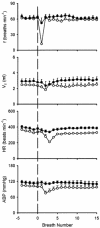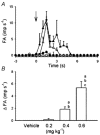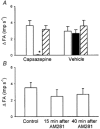Stimulation of pulmonary vagal C-fibres by anandamide in anaesthetized rats: role of vanilloid type 1 receptors
- PMID: 11897863
- PMCID: PMC2290177
- DOI: 10.1113/jphysiol.2001.013290
Stimulation of pulmonary vagal C-fibres by anandamide in anaesthetized rats: role of vanilloid type 1 receptors
Abstract
This study was carried out to determine the effect of intravenous injection of anandamide on pulmonary C-fibre afferents and the cardiorespiratory reflexes. In anaesthetized, spontaneously breathing rats, intravenous bolus injection of anandamide near the right atrium immediately elicited the pulmonary chemoreflex responses, characterized by apnoea, bradycardia and hypotension. After perineural treatment of both cervical vagi with capsaicin to block the conduction of C-fibres, anandamide no longer evoked these reflex responses. In open-chest, and artificially ventilated rats, anandamide injection evoked an abrupt and intense discharge in vagal pulmonary C-fibres in a dose-dependent manner. After injection of the high dose, the fibre discharge generally started within 1 s, reached a peak in approximately 2 s, and returned to baseline within 7 s. The stimulation of C-fibres by anandamide was completely and reversibly blocked by pretreatment with capsazepine, a competitive antagonist of the vanilloid type 1 receptor. Anandamide (0.4 mg kg(-1)) stimulated approximately 93 % of pulmonary C-fibres that were activated by capsaicin at a much lower dose (0.6 microg kg(-1)); the response to anandamide showed similar intensity, but had slightly longer latency and duration than that to capsaicin. In conclusion, intravenous bolus injection of anandamide evokes a consistent and distinct stimulatory effect on pulmonary C-fibre terminals, and this effect appears to be mediated through an activation of the vanilloid type 1 receptor.
Figures







 ) after pretreatment with capsazepine (3 mg kg−1; n = 11) or vehicle (n = 7). B, afferent responses to injections of anandamide (0.4–0.6 mg kg−1) before, and 15 and 40 min after pretreatment with AM281 (0.3 mg kg−1; n = 7). *P < 0.05, compared with the corresponding control. Data of each group are means ±
) after pretreatment with capsazepine (3 mg kg−1; n = 11) or vehicle (n = 7). B, afferent responses to injections of anandamide (0.4–0.6 mg kg−1) before, and 15 and 40 min after pretreatment with AM281 (0.3 mg kg−1; n = 7). *P < 0.05, compared with the corresponding control. Data of each group are means ±
Similar articles
-
Sensitization of capsaicin-sensitive lung vagal afferents by anandamide in rats: role of transient receptor potential vanilloid 1 receptors.J Appl Physiol (1985). 2009 Apr;106(4):1142-52. doi: 10.1152/japplphysiol.91229.2008. Epub 2009 Jan 8. J Appl Physiol (1985). 2009. PMID: 19131477
-
2-aminoethoxydiphenyl borate stimulates pulmonary C neurons via the activation of TRPV channels.Am J Physiol Lung Cell Mol Physiol. 2005 May;288(5):L932-41. doi: 10.1152/ajplung.00439.2004. Epub 2005 Jan 14. Am J Physiol Lung Cell Mol Physiol. 2005. PMID: 15653710 Free PMC article.
-
Activation of bronchopulmonary vagal afferent nerves with bradykinin, acid and vanilloid receptor agonists in wild-type and TRPV1-/- mice.J Physiol. 2004 Feb 15;555(Pt 1):115-23. doi: 10.1113/jphysiol.2003.054890. Epub 2003 Nov 21. J Physiol. 2004. PMID: 14634201 Free PMC article.
-
Functional morphology and physiological properties of bronchopulmonary C-fiber afferents.Anat Rec A Discov Mol Cell Evol Biol. 2003 Jan;270(1):17-24. doi: 10.1002/ar.a.10005. Anat Rec A Discov Mol Cell Evol Biol. 2003. PMID: 12494486 Review.
-
[Capsaicin-sensitive afferents in the vagus nerve].Ross Fiziol Zh Im I M Sechenova. 2001 Feb;87(2):182-203. Ross Fiziol Zh Im I M Sechenova. 2001. PMID: 11296704 Review. Russian.
Cited by
-
Sensory transduction of pulmonary reactive oxygen species by capsaicin-sensitive vagal lung afferent fibres in rats.J Physiol. 2005 Jun 1;565(Pt 2):563-78. doi: 10.1113/jphysiol.2005.086181. Epub 2005 Mar 31. J Physiol. 2005. PMID: 15802291 Free PMC article.
-
Pain and stress in a systems perspective: reciprocal neural, endocrine, and immune interactions.J Pain. 2008 Feb;9(2):122-45. doi: 10.1016/j.jpain.2007.09.006. Epub 2007 Dec 21. J Pain. 2008. PMID: 18088561 Free PMC article. Review.
-
Phrenic motor outputs in response to bronchopulmonary C-fibre activation following chronic cervical spinal cord injury.J Physiol. 2016 Oct 15;594(20):6009-6024. doi: 10.1113/JP272287. Epub 2016 Jun 3. J Physiol. 2016. PMID: 27106483 Free PMC article.
-
Altered expression of TRPV1 and sensitivity to capsaicin in pulmonary myelinated afferents following chronic airway inflammation in the rat.J Physiol. 2008 Dec 1;586(23):5771-86. doi: 10.1113/jphysiol.2008.161042. Epub 2008 Oct 2. J Physiol. 2008. PMID: 18832423 Free PMC article.
-
Stimulatory Effect of 5-Hydroxytryptamine (5-HT) on Rat Capsaicin-Sensitive Lung Vagal Sensory Neurons via Activation of 5-HT3 Receptors.Front Physiol. 2019 May 28;10:642. doi: 10.3389/fphys.2019.00642. eCollection 2019. Front Physiol. 2019. PMID: 31191346 Free PMC article.
References
-
- Bevan S, Geppetti P. Protons: small stimulants of capsaicin-sensitive sensory nerves. Trends in Neurosciences. 1994;17:509–512. - PubMed
-
- Caterina MJ, Schumacher MA, Tominaga M, Rosen TA, Levine JD, Julius D. The capsaicin receptor: a heat-activated ion channel in the pain pathway. Nature. 1997;389:816–824. - PubMed
-
- Coleridge JC, Coleridge HM. Afferent vagal C fibre innervation of the lungs and airways and its functional significance. Reviews of Physiology Biochemistry and Pharmacology. 1984;99:1–110. - PubMed
-
- Cosenza M, Gifford AN, Gatley SJ, Pyatt B, Liu Q, Makriyannis A, Volkow ND. Locomotor activity and occupancy of brain cannabinoid CB1 receptors by the antagonist/inverse agonist AM281. Synapse. 2000;38:477–482. - PubMed
Publication types
MeSH terms
Substances
Grants and funding
LinkOut - more resources
Full Text Sources

